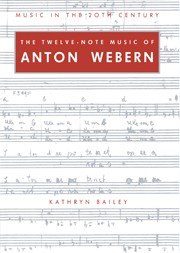Book contents
Summary
This chapter has two purposes. The more obvious – and probably the more immediately interesting – is to examine the unique treatment of the row in the individual pieces. It is these inspired realizations of the possibilities of the system that provide a measure of Webern's particular genius. Artistic creativity, however, consists of more than sheer invention: a talent for innovation is of little value without the sound basis of discipline. With this in mind, the second purpose of this chapter is to catalogue the elements of Webern's craft through an examination of his handling of mechanical details. It is those details that remain consistent from work to work that define a composer's style, and so it is that in order to understand Webern's style we must examine his treatment of the most basic elements of row technique and see how this changes from one work to the next.
Webern's understanding of the limits of the technique is very different from, say, Schoenberg's. He assiduously avoids the repetition of row segments and seldom sustains or repeats notes in such a way that their presence either precedes or outlives their mandate. He never moves backwards and forwards over a segment of the row; he does not use incomplete rows; nor does he consider hexachords with similar content to be interchangeable. After a few brief experiments in the early pieces he does not layer row segments; he almost never alters the order of notes prescribed by the row and does not return to notes already left. Nor does he ever exercise the licence to use the ‘wrong’ note.
- Type
- Chapter
- Information
- The Twelve-Note Music of Anton WebernOld Forms in a New Language, pp. 30 - 93Publisher: Cambridge University PressPrint publication year: 1991
- 1
- Cited by

